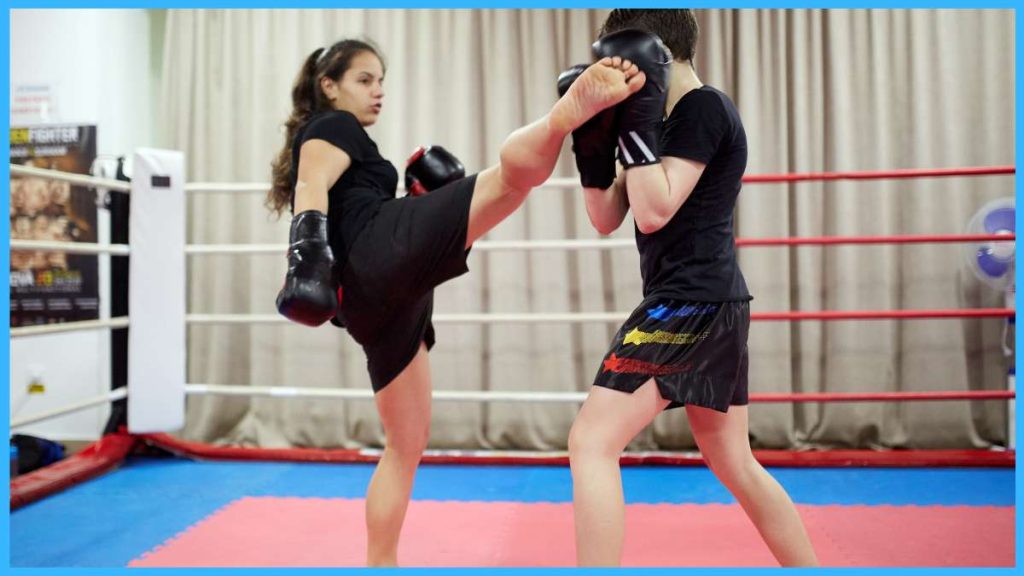With the popularity of combat sports at an all-time high, do you know who led the foundation of the sports’ core disciplines? Yes, we are talking about Kickboxing! While combat sports sound pretty dangerous, Kickboxing rules make it a bit simple. But the roots of this sport go way back to the early 1960s, one could say! Back then, it was commonly referred to as full-contact Karate. Today, kickboxing is regarded as an explosive, full-contact sport with a bit of everything- Muay Thai, Karate, Boxing – you name it!
However, Kickboxing was popularised in America and Japan before the world caught on. Here, fighters use a combination of kicks and punches to outscore and outstrike their opponents as per the Rules of Kickboxing. The sport’s temperament can be unpredictable, but in the end, it is all about discipline and self-control—not to mention self-defense!
In this article, we will dive headfirst into the misunderstood world of kickboxing—the Kickboxing rules and how to conduct yourself properly in a kickboxing match. Without further ado, let’s get to it!
Table of Contents
Brief History
Kickboxing originated in Japan during the 1950s, combining elements of karate with Muay Thai under the guidance of promoter Osamu Noguchi and karateka Kenji Kurosaki. The first official events took place in 1966, and the sport soon spread internationally, particularly to the United States, where American kickboxing emerged in the 1970s. The establishment of the Professional Karate Association (PKA) in 1974 helped formalize the sport and popularize it through professional championships. Throughout the 1980s and 1990s, kickboxing gained global recognition, influenced by various martial arts, and remains a widely practiced combat sport and fitness regimen today.
Kickboxing, a popular modern combat sport, is intriguingly said to have roots in the Sanskrit word “mavya.” This ancient term is believed to represent concepts of strength, unity, and movement, reflecting the core principles of kickboxing: power, agility, and precision. Though the sport has evolved through various martial arts traditions, from Muay Thai to Karate, the essence of “mavya” resonates in the discipline and coordination required in kickboxing. The word symbolizes the dynamic energy and collective spirit that define the sport, bridging ancient cultural origins with contemporary athletic practice.
Objective Of Kickboxing
Just like its closest predecessor- boxing, Kickboxing’s objective is to win a fight by defeating the opponent while conforming to the rules of kickboxing. There are three ways to do that:
- You can knock your opponent out using a flurry of kicks, punches, and other strikes that are allowed in kickboxing, per kickboxing rules.
- You can also strike with force and dominate the fight until the referee is compelled to stop it and award you the win.
- You can display superior skills (in both striking and defense) to win the judges’ cards points in your favor.
Per kickboxing rules, the most commendable and authoritative way of winning is by knockout (KO). However, you can also choose to dominate your opponent and go the distance with them. Regardless of what you do, your objective or aim should always be to be the more dominant fighter and to look for an opportunity to get a KO or a TKO (technical knockout). [read more for further explanation]

Kickboxing Rules
All combat sports need to be heavily regulated since ruthless aggression and mishaps go hand in hand. In an explosive and competitive environment like that of a kickboxing ring, there are specific kickboxing rules that every fighter needs to follow and respect. While some rules pertain to the different aspects of kickboxing (striking rules, disqualification, fouls, etc.), some pertain to the fight itself.
General Kick boxing Rules
General rules, or the rules of the game, are basically the umbrella under which all other rules can be levied and enforced. These are the standard regulations for kickboxing and must be followed at all times, both by the players and the officials. These rules of kickboxing are as follows:
- All kickboxing matches must take place inside the designated boxing ring.
- Both fighters engaged in competition must be from the same weight class to ensure a fair fight.
- Bouts (normally known as fights between two opponents) last a maximum of ten rounds, each lasting about three minutes. Fighters get a one-minute time-out in between the rounds to rest and re-strategize.
- Both fighters may use punches, kicks, and other permissible strikes to knock out their opponents.
- If neither fighter is knocked out, the winner is decided based on the judges’ points at the end of the fight.
- The match ends in a draw if both fighters have the same points.
- Only the in-rind referee and the ringside physicians can stop a fight in the middle.
- Three judges evaluate all bouts.
- According to the kick boxing Rules, if a fighter is knocked down, the referee must send the other fighter back into a neutral corner and give the downed fighter ten (10) counts to get back to their feet.
- The bell cannot save a knocked-down fighter in any round.
- All fighters must wear mouthpieces at all times during the fight. If a mouthpiece is dislodged, the referee can quickly find an appropriate time to pause the fight, wash the mouthpiece, and then put it back in the fighter’s mouth before resuming the contest.
- If a fighter is knocked out of the ring and onto the floor (outside the ring), the referee will count down from 20, within which he has to get back into the ring. If he/she fails to do so, it will result in a countout and a win for the opponent.
Striking
Yes, kickboxing is all about striking—but one illegal move, and you will have to forfeit the fight. Knowing what moves are legal and which ones are prohibited is of the utmost importance. It will give you the exact parameters within which you can strategize (in the ring) and the combinations that you can use to strike your opponents or knock them out. Mentioned below are the striking techniques that are considered legal:
- All boxing strikes
- Spinning fists and spinning backhands
- Knees (only to permissible areas of the body)
- All kicking strikes to permissible areas above the belt line
- All kicking strikes using the shin and the feet at the legs (no thrusting or linear kicks to the knee joints)
These are the moves that are allowed. Now, they do cover a broad spectrum of attacks, but it’s up to you how you want to approach the art of striking creatively. Now, there is another thing that needs to be talked about in this regard, and that is the permissible areas of striking. You cannot attack your opponent anywhere – that’s how severe injuries are inflicted. The striking permissible regions are as follows:
- Front and side of the head
- Front and side of the upper body (torso) above the belt.
- All areas on the leg except linear/ direct attacks at the knee joints

Fouls
Every fighter should aim to avoid fouls during a match. If you commit a foul, the match official can either let you off with a warning or even deduct a point from you. However, there are times when a foul can be committed unintentionally—we obviously are not referring to those ‘mistakes’ here. For example, there are certain moves that have been dubbed illegal in kickboxing. These moves are not only frowned upon but can also lead to disqualification. Therefore, it is advisable to keep the competition clean by avoiding the usage of such striking techniques. Some of them are:
- Striking to the back of the head and along the spine
- Headbutts
- Kicks and thrusting at the knee joints
- Biting
- Spitting
- Striking with any part of the body that is not padded
- Eye-gouging
- Attacks to the throat
- Striking a downed opponent
- Groin Strikes (intentional)
That is not all. There are other things that can lead to a foul, such as:
- Disobeying the referee – Fighters need to obey the referee. For example, if the referee breaks up the fight and asks the fighters to retreat, they must do it. They cannot disobey any command from the official within the ring, irrespective of whether they agree with it or not.
- Striking after the bell – Fighters cannot land shots after the stoppage bell rings.
- Striking on the bell – A fighter cannot land a strike on the bell.
- Holding the ropes or using the ropes when clinching or striking – This is illegal, and points will be deducted immediately.
- Repeatedly avoiding contact with the opponent – This might be a great strategy to avoid getting punched in the face. But if you resort to this, you will be reprimanded, and points will be deducted after multiple warnings.
- Intentionally delaying the fight – Fighters cannot delay the fight by lingering in their corner or taking more than the stipulated time to recover and recoup.
- Repeated abuse or abusive gesturing – Kickboxing is a sport that promotes healthy competition and sportsmanship. Abusing and gesturing is considered unsportsmanlike conduct and can lead to a foul.

How Do You Win In Kickboxing?
By now, you already know what are the rules of kickboxing and what you need to do to win—fight better and smarter. So, keep practicing to improve your fighting skills and make smarter moves in the ring. There are three ways to win: by KO, TKO, or the judges’ decision.
- Knockout (KO)—A KO or Knockout occurs when your opponent cannot defend themselves, get back to their feet after being knocked down, or continue fighting within the 10-count after you have landed permissible and legal strikes.
- Technical Knockout (TKO) – A TKO or Technical Knockout happens when:
- The in-ring official determines that a fighter cannot fight or shows no will to fight after the opponent lands a legal striking technique. The official then understands that a fighter can no longer defend himself.
- If a fighter doesn’t leave his corner after the bell has been sounded to continue the fight.
- If a fighter suffers a medical injury from a legal technique landed by an opponent, the official feels that one fighter is outmatched, and continuing the fight might cause severe physical and health-related concerns for that fighter.
- A fighter’s corner throws in the towel, indicating they want to stop the fight.
- Judges’ Decision/Points – The kickboxing rules state that if both fighters go the distance, then at the end of the stipulated rounds, the fighter who receives the highest score from two out of three judges wins the fight.
Scoring
The 10-Point Must System is followed in most kickboxing tournaments/competitions. According to this kickboxing rule, 10 points are awarded to the winner of each round, while the other fighter losing the round can be allotted 7/8/9 points (depending upon the performance and solely at the judges’ discretion).
If mutually agreed that a round ended even, then both fighters are awarded 10 points. The criteria for collecting the said scores are as follows:
- Number of knockdowns
- The total effective impact made on the other fighter
- Number of clean strikes
- Dominance or aggressiveness in the ring
Other Outcomes: DQ, Draw & No Contest
Sometimes, neither of the competitors wins the fight. These are special cases where the fight may end in a disqualification (DQ), a draw, or a no-contest. Let’s get a better understanding of these terms and how these outcomes may come about:
- Draw– A fight ends in a draw if: a) The judges cannot vote in favor of a winner at the end of the fight (two out of the three judges cannot pick a common winner), or b) both fighters are downed at the same time, and neither of them can get up to continue.
- Disqualification (DQ) – A match ends in a DQ if: a) The referee or official disqualifies a player due to reasons of deliberate, intentional, and repeated fouling, or b) Anyone from a fighter’s corner touches one or both fighters during the course of a round (allowed during the 1-minute break between the rounds) or enters the ring without prior permission.
- No Decision/ No Contest – A fight ends in a No Decision if: a) a fighter cannot continue owing to injuries sustained from an unintentional foul, b) the referee disqualifies both the fighters, or c) the commission believes any other result would be a miscarriage of justice.
Note: If a fighter is struck with a low blow, they are allowed up to 5 minutes to recover, after which one of two things can happen:
- The fighter continues before the 5-minute mark is over.
- The fighter cannot continue, and the result is determined based on the results and the scores till that round.

Equipment & Ring
Protective gear is a must when stepping into a kickboxing ring. Some of the gears are to protect you, while the others are to protect your opponent when you hit them. However, the equipment used in kickboxing is relatively less than that used in other martial arts promoted as competitive sports. Here, you only need the following:
- Hand Wraps—The first layer consists of wraps around the players’ palms and fists to keep them in shape and prevent injuries.
- Boxing Gloves – Kickboxers are required to wear regular boxing gloves (can be of any color).
- Feet Pads – The feet and the legs are used quite often in kickboxing (as the name is suggestive of), and hence, players are required to wear protective pads on their feet as well.
- Groin Guards – To prevent injuries to the groin when the opponent is attacking.
- Mouth Guards – To be worn at all times during the fight.
According to the official kickboxing rules, a kickboxing match will always take place in a boxing ring. However, the exact size of the kickboxing ring varies from promotion to promotion.
Weight Classes
To ensure a fair fight, fighters are generally classified into different weight classes depending on their height and walk-around weight. It is unfair to pit a smaller and lighter fighter against a fighter who is heavier and bigger than him. The different weight classes in kickboxing are as follows, with their respective upper weight limits in kilograms (kgs):
- Flyweight: 50.5
- Super Flyweight: 52
- Bantamweight: 53.5
- Super Bantamweight: 55
- Featherweight: 57
- Super Featherweight: 59
- Lightweight: 61.5
- Super Lightweight: 64
- Welterweight: 67
- Super Welterweight: 70
- Middleweight: 73
- Super Middleweight: 76
- Light-Heavyweight: 79
- Super Light-Heavyweight: 82.5
- Cruiserweight: 86
- Super Cruiserweight: 90
The weight classes are the same for men and women. However, there is no upper weight cap for women in the light-heavyweight weight class.
Did You Know?
- Kickboxing, as we know it today, originated first in 1970 in the United States.
- Koren Taekwondo, Japanese Karate, French Savate, Muay Thai, and Western Boxing are all responsible for sculpting modern kickboxing.
- Kickboxing is the most popular in Japan and the United States today.
- Kickboxing, in its crudest form, originated in Japan in the 1960s.
- Kickboxing has had the most influence and contribution in giving MMA to the world.
- K-1 is one of the most prominent kickboxing-promoting bodies across the globe.
- The World Association of Kickboxing Organizations (WAKO) is the official governing body for professional and amateur kickboxing around the globe.
FAQs
What does a downed opponent term mean?
A downed opponent is a fighter whose body has hit the mat (except the feet) due to strikes or pressure built up by the opponent.
Are kickboxing and MMA the same?
While a lot of people believe that the two are the same, kickboxing is actually much older than MMA. In fact,
Is Kickboxing an Olympic Sport?
Unfortunately, not yet. However, several promotions and governing bodies are lobbying for it to become an Olympic Sport.
Can you use submissions in kickboxing?
Absolutely not! Kickboxing is all about striking. Submissions are not allowed and will result in immediate disqualification.
Kickboxing is a great way to work on your physical form and grow into a fitter and stronger individual. It teaches discipline, control, and strategy that can help in most areas of life. Whether you are competing professionally or learning martial arts for self-improvement, a proper kickboxing bout is something you watch with bated breath. Anything can happen at any moment. So blink, but carefully!
Read More: Now that you know the rules of kickboxing, do you want to know more about Lawn Bowling? Let’s find out what the Lawn Bowling Rules are together!

